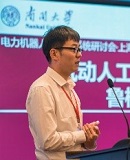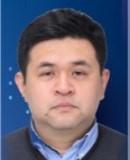主题演讲人
 王贺升教授
王贺升教授
上海交通大学
Research interests: visual servoing, service robot, robot control and computer vision
Speech Title: Visual Servoing of Robots
Abstract: Visual servoing is an important technique that uses visual information for the feedback control of robots. By directly incorporating visual feedback in the dynamic control loop, it is possible to enhance the system stability and the control performance. Many challenges appear when robots come to our daily life. Compare to industrial applications, the robot need deal with many unexpected situations in unstructured environments. The system should estimate the depth information, the target information and many other information online. In this talk, various visual servoing approaches will be presented to work in unstructured environments. These methods are also implemented in many robot systems such as manipulator, mobile robot, soft robot, quadrotor and so on.
 孙宁教授
孙宁教授
南开大学
Research interests: Control for land-fixed/offshore cranes, underactuated robots, and other mechatronic systems
Speech Title: Nonlinear Control of Robots Actuated by Pneumatic Artificial Muscles: Theory and Experiments
Abstract: With the rapid development of rehabilitation robots and the growing demands for human-robot interaction, modeling and intelligent control of pneumatic artificial muscle (PAM) robots have increasingly attracted the attention of many researchers. It is a challenging research topic to overcome the effects of PAMs’ inherent defects (e.g., high nonlinearities, hysteresis, time-varying characteristics, etc.), despite the merits of lightness, safety, and high power-to-weight/volume ratios of PAMs. To this end, we aim to achieve accurate modeling and advanced control for PAM robots, which may contribute to their further theoretical research and practical applications. Specifically, for single-PAM robots, there exist some difficulties as follows: 1) PAM systems are susceptible to unknown external disturbances due to their high nonlinearities, creep, hysteresis, etc. 2) PAM robots usually suffer from parameter uncertainties and unmodeled dynamics. 3) The ultimate control inputs (corresponding to the pressurized air) of PAM robots should be constrained to be nonnegative. To solve these problems, we propose a disturbance estimation-based nonlinear control method, a neuroadaptive control method with system uncertainties, and an adaptive control method with unidirectional input constraints, respectively. Further, for multi-PAM robots, the following issues should be considered: 1) Since torques/forces are generated by air pressure and are not the ultimate control inputs, the torque models of PAM robots are not direct and effective. 2) To ensure safety, the system state variables (e.g., contracted lengths of muscles, ranges of robots’ movements, etc.) are usually limited. To this end, we propose an accurate dynamic modeling method and a nonlinear control method with overshoot constraints, respectively. Some future research directions will also be discussed.
 谢福贵教授
谢福贵教授
清华大学
Research interests: Theory and design on the issues of mechanisms, Parallel kinematics machines, Parallel robots, Advanced manufacturing equipments
Speech Title: A Portable Machining Robot: Design, Key Technologies and Application
Abstract: In aerospace, energy and shipbuilding sectors, manufacturing of large-scale components for major technical equipment is in urgent need of portable or movable high-performance multi-axis NC equipment. Typical examples include the processing of large structural parts in heavy-duty gas turbines and remote maintenance of large-scale equipment. In order to realize the innovative design of such high-performance manufacturing equipment and the R & D of the whole machine system, this report firstly studies a five-axis parallel machining robot with focuses on innovative design of its mechanism and kinematics optimization. Thereafter, it probes into the key technologies such as inertia matching, trajectory planning and accuracy assurance, for high-efficiency and high-quality machining applications. This report also covers the development of a series of robotic systems derived from this robot, and their applications in the machining of typical parts such as the frame-type structural parts, spacecraft cabin, and etc.
 Duc Truong Pham教授
Duc Truong Pham教授
University of Birmingham, UK
Research interests: Rapid manufacturing, micro manufacturing, automation, robotics, IT and intelligent systems.
Speech Title: Research into Robotic Disassembly for Smart Remanufacturing
Abstract: Remanufacturing is the process of returning a used product to at least the same condition as the original product. Remanufacturing is sustainable manufacturing, helping to save resources (raw materials, energy, water, etc.), reduce greenhouse gas emissions and avoid the need for landfill space. Remanufacturing is part of a circular economy. Disassembly is the first operation in remanufacturing. How disassembly is undertaken can affect the efficiency and capability of remanufacturing. Disassembly is labour intensive and difficult to automate due to variabilities in the condition of the product at the end of its service life. Efforts have been spent on introducing intelligent robots in disassembly to make remanufacturing ‘smarter’. Like other applications of Industry 4.0 automation technologies, this should lead to increased productivity, reduced failure rate, more resource-efficient operations and improved product quality and working environment.
This presentation will cover research conducted as part of the 5-year Autonomous Remanufacturing (AutoReman) research programme funded by the UK Engineering and Physical Sciences Research Council at the University of Birmingham. In addition to fundamental research into disassembly science, the work has also involved developing and using tools and techniques typical of those in the era of the fourth industrial revolution to allow disassembly to be reliably performed by machines.
AutoReman has produced results relevant to researchers in robotic assembly and disassembly, and in remanufacturing and recycling. The control strategies developed for disassembly robots to adapt to uncertainties are usable in other robotic applications including assembly. The proposed autonomous disassembly techniques can be employed for efficient recycling as well as remanufacturing. Without doubt, AutoReman has taken the first steps to help usher remanufacturing into the digital age.
 王宏志教授
王宏志教授
哈尔滨工业大学计算机学院
Research interests: Database Management System; Big Data Quality; Big Data Analysis and Mining; AI for DB; DB for AI; Industrial Big Data; Blockchain and Financial Big Data
Speech Title: Time Series Management and Analytics: the Base of Modern Society
Abstract: Time series is crucial in many applications in various aspects of modern society including manufactory, finance, smart city and online education. The effective management and analytics of time series play important roles in modern society, which also bring the challenges of strong co-relationship, continues data types and ordered time window. In this talk, I will introduce the applications of time series, the challenges of time series management and analytics as well as our research results in this area including time series database, various kinds of time series analytics algorithms and time series cleaning algorithms and systems.
特邀报告人
Dr. Yuchen Jiang, Assistant Professor with Harbin Institute of Technology
Speech title: Towards improved safety of industrial cyber-physical systems
Dr. Xiaoqiang Hua, lecturer with the National University of Defense Technology
